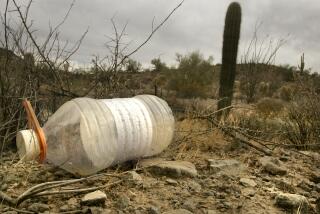Marlin take kayaker on the ride of his life
- Share via
Kayak fishing is generally a serene endeavor, similar to float-tube fishing.
But when you attach a marlin to the end of your line, it becomes more of a sleigh ride, during which you hold on for dear life and hope the beast you’ve hooked doesn’t take it personally.
“I never took up water skiing, but it must be a little like that,” says Jon Schwartz, who last week off Cabo San Lucas caught and released eight marlin from aboard a rented yellow kayak.
“Because when the marlin turns in one direction, you pull your rod in the other and that points your kayak toward the line. So you’re actually steering.”
Some might regard the Carlsbad schoolteacher, a husband and father of three, as irresponsible. Or just plain crazy.
Hooked marlin have turned on their pursuers, attacking and even leaping into boats.
But “Bluewater Jon,” as he refers to himself, says there are far more dangerous activities and acknowledges only being “a bit of a goofball.”
Schwartz had received reports of dense marlin concentrations at the Golden Gate and Finger Bank north of Cabo San Lucas at Baja California’s tip.
So he chartered a Pisces Sportfishing cruiser and was deposited at the less-crowded Finger Bank.
A big-game specialist, he uses a short, stand-up-style rod because it’s easier to handle aboard a kayak. He also uses circle hooks, which can be set merely by tightening the lever drag as the tough-mouthed billfish make their run.
Plus, circle hooks usually set in the corner of a fish’s mouth, making for easier releases.
The cruiser’s crew and a videographer -- check out bluewaterjon.com -- were kept entertained as Schwartz streaked across the Pacific, powered by greyhounds of the sea.
He battled each marlin for about 30 minutes, and with a gloved hand he held their bills while using pliers to free the hook.
“Some towed me several miles, and some much less than that because they jumped so much,” Schwartz recalls. “One must have jumped 12 times in a circle around me, no more than 20 feet away.”
Asked if he had to check his body for holes afterward, he replied, “I haven’t been skewered yet.”
Bass anglers ‘in arms’
The Casitas Municipal Water District is considering banning private boats from Lake Casitas in an attempt to thwart an invasion of quagga mussels.
The tiny mussels multiply rapidly, compete with native critters for food and can be devastating to water systems and fisheries.
They’ve been detected recently at other Southland reservoirs and are known to hitch rides on boat hulls and motors.
Anglers are “up in arms, kicking and screaming” over prospects of a ban, says Randy King, concession manager at the Ventura County reservoir, which is one of the West’s premier largemouth bass fisheries.
Rental boats would still be allowed, but they lack adequate platforms and trolling motors necessary to maneuver around a shoreline.
A vote is expected by month’s end.
Extreme adventure
Adventurer Doug Stoop and Richard Dunwoody, his client, have been dragging 250-pound sleds across Antarctica since Dec. 1 and are a week from reaching the South Pole.
Their route is the same one Ernest Shackleton planned to attempt during his ill-fated expedition in 1915, when his ship, Endurance, became trapped by ice and sank, forcing his crew to endure 22 months in the frozen region.
Reached via satellite phone, Stoop said he and Dunwoody were dining on freeze-dried chicken fettuccine.
The temperature was minus 21, which is warm for the Polar Plateau, Stoop said.
Theirs is an unsupported adventure, the first on a grueling route fraught with ice ridges and dangerous crevasse fields.
Stoop fell into a deep crevasse but caught a small ledge with a ski tip and used his poles to climb to safety.
They pack plenty of food but burn more calories than they consume and both have lost at least 20 pounds, making it difficult to keep warm. Their routine is the same each day: cover all skin and ski with sleds in tow for an average of 10 miles a day.
White-out conditions are so severe, at times, that they cannot discern up from down so they lose equilibrium and stumble like drunks.
“That happens a lot and it’s quite funny,” Stoop said.
It is a surrealistically beautiful landscape, but they’re weary and long for better food and things that ordinary people take for granted.
“I miss the smells of trees and grass and that kind of thing,” Stoop said. “I also miss color. I haven’t seen color in a while. All I see is white.”
The expedition website is beyondshackleton.com.
Storm surfing
Last Saturday four surfers embarked to Cortes Bank, 105 miles off Orange County, and found peaks measuring 80 feet breaking over the high spot.
Mike Parsons, Brad Gerlach, Greg Long and Grant Baker used Jet Skis to tow each other onto the massive shoulders, whereupon they “rode the biggest waves of our lives by far,” said Long, of San Clemente.
The voyage was planned after Surfline.com forecaster Sean Collins pinpointed a narrow window of opportunity between the weekend storms. Photos are posted at billabongxxl.com.
Closing quote
Sea Shepherd Conservation Society founder Paul Watson, as his newly repaired vessel steamed toward the Antarctic, on Japan’s controversial whaling operation underway there:
“The blood of the whales is flowing freely amidst the heartbreaking screams of whales dying in horrific agony at the hands of black-hearted cetacean serial killers.”
Sea Shepherd and Greenpeace will attempt to interrupt the slaughter.
--
More to Read
Sign up for The Wild
We’ll help you find the best places to hike, bike and run, as well as the perfect silent spots for meditation and yoga.
You may occasionally receive promotional content from the Los Angeles Times.






